From the land and the sea, Nova Scotia is a treasure chest of epicurean bounty. For me, that bounty included several first-time experiences and a few surprises. I didn’t know very much about Nova Scotia food and wine prior to my visit which made the prospect of my culinary road trip all the more exciting. I was eager to broaden my horizons with new seafood experiences and discover the province’s quickly-growing wine industry.
Since Nova Scotia is renowned for having an abundance of fresh seafood harvested from the cold, clean waters of the North Atlantic, I determined that this would be the right place to sample first-time-for-me seafood dishes that I’d thus far had a reluctance to try. In addition to new seafood discoveries, my experiences included sampling the delicious spectrum of Nova Scotia wines.
Discovering Nova Scotia Wine
I must admit that Nova Scotia hadn’t previously come to my mind when contemplating the world’s wine regions. It was news to me that grapes could even grow in Nova Scotia let alone that they had been cultivated for over 300 years and that in recent years a flourishing wine industry had developed. There are currently 15 licensed wineries and over 70 grape growers with more than 550 acres under vine across the province. Those numbers are expected to increase as consumption of Nova Scotia wines and the profitability of making them grows.
The wines I tasted surprised me by their quality and originality. Nova Scotia winemakers are capitalizing on the intrinsic characteristics of the grapes that grow well in their soil and climate with coastal breezes.
Although there are numerous red wines being produced (and I tried some very good ones), the whites wines are the crown jewels — light, crisp, and beautifully paired with the fresh seafood or enjoyed alone.There are two whites, in particular, that are quintessentially Nova Scotia.
In 2012, Nova Scotia launched its very own appellation, Tidal Bay, to become the province’s signature white. The name reflects the influence of the sea on the wines produced here – and of course, the famous tidal bore of the Bay of Fundy. Tasting several Tidal Bay vintages from various wineries, I was impressed that each was unique. Vintners create their own style of Tidal Bay blending diverse proportions of approved grapes, while keeping within appellation guidelines to maintain the prominent characteristics of Nova Scotia wine and not exceed 11% alcohol.
My first taste of Tidal Bay was that of Gaspereau Vineyards and I immediately took a liking to it. It is a refreshing and crisp wine, perfect to drink while watching the boats on the harbor in the late afternoon as I did at a reception at Pier 21 in Halifax. Gaspereau’s winemaker Gina Haverstock makes her Tidal Bay from a blend of Seyval Blanc, Vidal Blanc, Pinot Grigio, and Muscat grapes.
I also enjoyed what is considered to be a classic Nova Scotia wine, L’Acadie Blanc, a dry white wine first produced at Grand Pré Winery in the 1970s. L’Acadie Blanc is the most widely planted grape variety in the province. It has been compared to Chardonnay and most recently to Sauvignon Blanc. If you typically imbibe in those whites, this is a great go-to Nova Scotia wine, but I encourage you to try the full range of offerings — red, rose, white, sparkling, and ice wines and the various styles within each type.
Currently, there is limited distribution of any Nova Scotia wine beyond the province, so when you visit (and I hope and highly recommend that you do), be sure to check customs regulation and bring back whatever you can!
Wining and Dining
Luckett Vineyards
It was fun to learn that well-known vineyard and gourmet food boutique owner Pete Luckett of Luckett Vineyards had once been a Queen’s Guardman back in his native England; perhaps as a counter-reaction to the time he spent standing guard motionless and speechless, he had an overwhelming propensity to chat up the tourists. Pete is very energetic and charming as he welcomes visitors setting an upbeat mood in the bright and lively tasting room and throughout the winery.
On this picture-perfect day, our lunch on Luckett’s Crush Pad Bistro patio (seen in the photo at the top of this post) was a lovely way to spend an afternoon.
Pete gave us a tour through the vineyards that sit high on a hill above the Gaspereau Valley with views of the Minas Basis (an inlet of the Bay of Fundy) and the bluffs beyond. The red English phone box in the middle of the vineyards (shown below) was brought from Luckett’s own neighborhood in England and adds to the memorable experience — visitors can make a call from it to anywhere in North America. The phone box is an important aspect of the Luckett brand.
In the tasting room we sampled several wines, including Black Cab (a blend of Cabernet Franc and Castel grapes) one of the more full-bodied red wines I had in Nova Scotia. Black Cab was recently announced as a gold medal winner in the Atlantic Canadian Wine Awards 2014 competition.
When it comes to wine, I know what I like … but I find that I’m rarely able to improve on the descriptive and often poetic words used by the wineries in referring to their own wines. So for each winery in this post, I’ve made a few recommendations which are my own; however, I’ve used the wineries’ descriptions.
My picks, Luckett tasting notes:
2013 Phone Box White A golden blend of Osceola Muscat, Traminette and L’Acadie, our signature Phone Box White delivers a refreshing floral, apricot flavour touched with a whisper of fresh garden herbs. With a soft round mouth feel, this easy-drinking wine answers the call of Nova Scotian lobster dinners, Digby scallops and BBQ’d chicken.
2012 Phone Box Red Our signature Red is dialed into the flavours of our finest wines. Phone Box Red is aged in oak barrels to create robust, well-structured layers of ripe fruit flavours that answer the call of hearty stews, red meats and grilled dishes.
2012 Rosetta Perfectly dialed in to summer flavours, Rosetta is off-dry and refreshing with notes of strawberry, rhubarb, watermelon and citrus fruits. This beautifully blushed rose makes a strong connection with poultry, pork, tomato-based pastas and pizza, and can be served slightly chilled for a real crowd pleaser.
Domaine de Grand Pre
Domaine de Grand Pré is the oldest winery in Nova Scotia. It was bought in 1993 by the engaging Hanspeter Stutz, a Swiss businessman, who spent several years renovating the property and winery before the grand reopening in 2000. He has received a very special accolade, the Queen Elizabeth II Diamond Jubilee Award, for “contribution to the County, the Province and the Country”. The wines, crafted by his winemaker son Jürg, are award-winners, too.
The estate’s restaurant Le Caveau (which includes a lovely terrace, the “pergola”) and tasting room are beautifully situated on landscaped grounds that evoke the French countryside. After sampling a variety of Grand Pré wines poured by Hanspeter in the tasting room and retail shop, we moved to the comfortable, yet elegant Le Caveau for dinner where we were graciously served by Hanspeter’s daughter and restaurant manager, Beatrice Stutz.
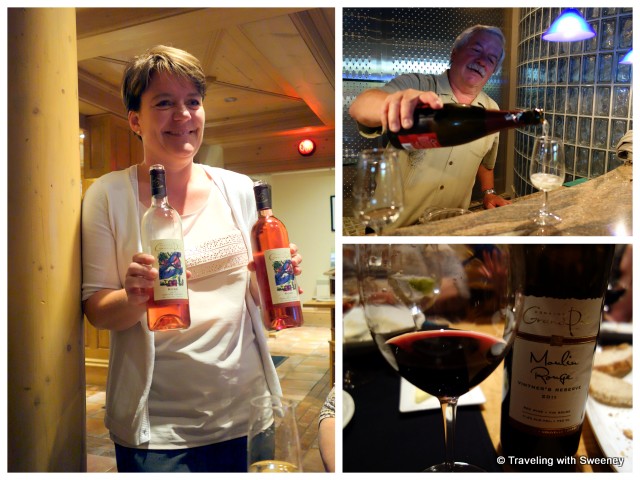
Restaurant manager, Beatrice Stutz, Hanspeter Stutz, and one of my favorite wines — Grand Pré Moulin Rouge
The ambiance was vibrant as we enjoyed several of Chef Jason Lynch’s creative and delicious dishes, including my favorite — Grilled Nova Scotia Sea Scallops with prosciutto (below left). We also had a peek at the action in the kitchen and the pleasure of chatting with Hanspeter and Chef Jason during dinner.
It was also here that I had an exciting new food experience – raw oysters; I believe Nova Scotia and particularly Le Caveau, was the perfect place for this event. I’m not sure if I’ve fully developed a taste for them yet, but I’m ready to go back for more.
My picks, Grand Pré tasting notes:
Champlain Sparkling Wine We have named this traditional method sparkling wine after Samuel de Champlain who mapped Nova Scotia during the earliest French and Acadian settlement in what was then L’Acadie. This sparkling wine has been made from a blend of L’Acadie Blanc and Seyval Blanc grapes grown here on the slopes above Grand Pré meadows.
Moulin Rouge Vintner’s Reserve This fun red wine is the result of blending some of the best varieties that Nova Scotia has to offer, including Baco Noir, Marechal Foch, Leon Millot, Castel and even some L’Acadie Blanc. It is a wine with many layers, offering aromas of plum and ripe summer berries, supported by mineral notes and a touch of oak.
Vidal Ice Wine This Vidal Icewine was hand picked at Warner Vineyards in Lakeville, N.S. at the end of the old and the beginning of the new millennium. It displays notes of apricots, lemon, blood orange and marmalade. It is balanced with crisp acidity and a long, lingering, sweet finish. Sip this rare treat by itself or as a sweet compliment to a dessert.
Avondale Sky Winery
A winery in a church is unusual enough, but this structure at Avondale Sky Winery was moved from another location about 26 miles away via road and ferry. Owners Lorraine Vassalo and Stewart Creaser initially salvaged and moved an old barn several miles from the vineyard instead of constructing a new building for the winery. Later, they were told that St. Matthews Church in Walton was going to be destroyed unless an owner was found. Of course, they couldn’t let that happen! With much fanfare and relief on the part of those who treasured the old church, the building was moved to its new location at Avondale.
Among the lovely selection of Avondale wines crafted by winemaker Ben Swetnam is a signature wine called Bliss reflecting how Lorraine feels about the winery and vineyards — her “happy place”. Taking a stroll up the hill and into the vineyards while sipping a glass of Bliss, I totally got it.
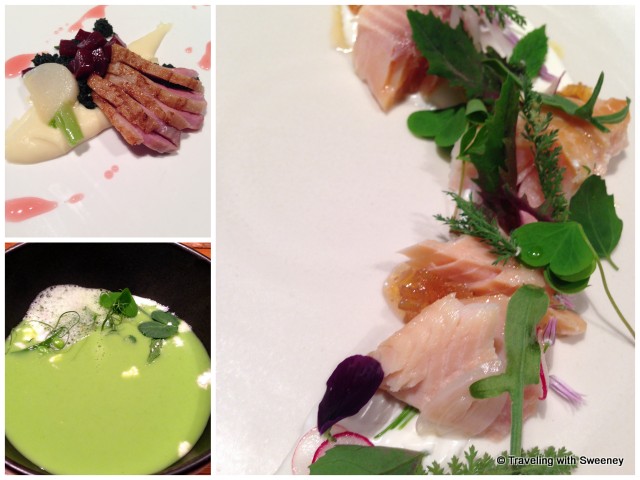
From bottom left: Chef Dave Smart’s Chilled Pea Soup, Duck Breast with parsnip puree, Smoked Arctic Char
My picks, Avondale Sky tasting notes:
2013 Bliss The nose shows notes of green apple, pear, starfruit, and lime with cinnamon spice and chalky minerality from our terroir. The palate is clean and crisp with a touch of spritz that leads to a long citrus finish.
2013 Tidal Bay The nose shows notes of grapefruit, gooseberry, peach, and apple, with a hint of toast and spice. The palate is soft, yet fresh, with wisps of butterscotch from the oaked component. The finish shows lingering spice and clean mineral tones.
2013 Lady Slipper On the nose this wine shows notes of dark cherry, cranberry, raspberry, and orange zest, with a distinct cinnamon spiciness. The palate is fresh and crisp, with red fruit and spice. The wine has a nice balance between sweetness and acidity with a chalky mineral finish.
A few more sips of sparkling wine
Blomidon Estate Vineyards has a prime location on the Minas Basin (an inlet of the Bay of Fundy). We stopped in for a tasting and I quickly developed a penchant for their sparkling wines, in particular. In fact, I used Crémant as a key ingredient in my cocktail creation, the Nova Scotia Surprise. The 2011 Crémant was a silver medal winner at the 2013 National Wine Awards.
My picks, Blomidon tasting notes:
2011 Crémant Our Crémant is crafted in a style extremely well-suited to Nova Scotia’s climate. It’s light on the palate, is under lower pressure than a typical Méthode Traditionelle wine, and the fresh, bright fruit aromatics complement the hint of sweetness. Seriously drinkable, the low alcohol content (10% alc./vol.) makes this a go-to brunch or aperitif wine.
2010 Cuvée L’Acadie This Méthode Traditionelle sparkling wine is made from 100% L’Acadie Blanc grapes from our ocean side estate vineyard and aged for 18 months prior to disgorging. Rated Brut (Dry), this wine marries classic L’Acadie Blanc citrus, stone fruit and pineapple aromas with the rich toasty brioche notes of extended aging.
Atlantica Hotel and Marina Oak Island
Mussels — now I know what the fuss is about. I consumed a fairly large bowl full of mussels (a first for me) at Atlantica Hotel and Marina Oak Island where Chef Konrad Haumering prepared a fantastic lunch for our small group. Another heaping bowl was offered, but I was saving room for the fresh halibut about to be served.
I’ve always enjoyed halibut, but I’ve never had it so freshly caught, then fileted and cooked in the kitchen right before me. It was scrumptiously garnished with pistachio-crusted sea scallops and creamy saffron sauce. We were also served warm bread right out of the oven. Top all of that off with scenic views of Mahone Bay and it became another meal to remember.
Hall’s Harbour Lobster Pound
Look at the size of the lobster shown below! It weighs in at about 8 pounds and would probably cost about $75 if you could order it in a Nova Scotia restaurant. During our “Lobster 101” session at Hall’s Harbour Lobster Pound, local resident and lobster expert, Lowell Simpson told us that it’s a myth that big lobsters are tough. He’d love to eat a lobster this size, but this one is just for show. He also demonstrated how to lull a lobster to sleep — you have to see it.
Lobster is so plentiful in Nova Scotia that it was once considered the poor man’s food. Imagine that! I heard several stories of the old days when children whose mothers packed lobster lunches would try to trade with others for their sandwiches.
At Hall’s Harbour Lobster Pound the lobster is as fresh as it gets. So this was the place where I had my first real lobster experience. I’ve had lobster before, but only when someone else retrieved all of the tasty white meat from the shell for me.
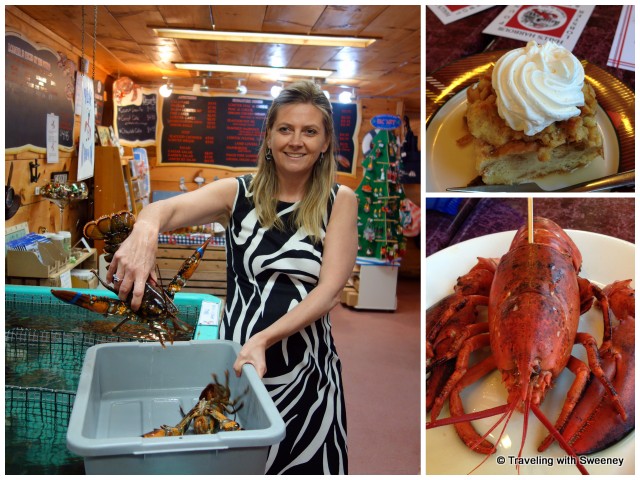
Hall’s Harbour General Manager Sharla Cameron selecting my live lobster, lobster ready to eat, and their signature apple bread pudding for dessert
Here, it was my challenge to crack, pick and open my own lobster selected right from the tank. Although I successfully grabbed the tasty meat from the claws, I didn’t do so well separating the body from the tail and made a bit of a mess. Fortunately, I was then aided by my more lobster-savvy travel mates. Obviously, I need more practice and would love to return to Hall’s Harbour to try again. By the way, the restaurant was recently recognized with an award by Eastlink TV as having the “Best Lobster in Nova Scotia”.
The Chowder Trail
Come to Nova Scotia and you must eat chowder — and have it often. With the abundance of seafood and other fresh ingredients, seafood chowder is a commonly found dish throughout Nova Scotia. In fact, Taste of Nova Scotia (the culinary association with over 140 producer, processor and restaurant members) is running their 2014 “Chowder Trail” campaign into October 2014 that encourages chowder lovers to use a “Chowder Trail Passport” to check off and rate the chowders of as many as 60 establishments as they dine around the province.
At Salt Shaker Deli in Lunenburg, I ordered the special of the day — corn chowder (shown in the photo above, top left), although I was tempted by the restaurant’s seafood chowder which is made up of scallops, mussels, shrimp and smoked haddock. At the Halifax reception I mentioned, Chef Mark Gabrieau prepared a Thai-style chowder (above right) with the same main ingredients he uses at Gabrieau’s Bistro in Antigonish – baby shrimp, salmon, lobster meat, baby clams and crabmeat. Chowder recipes vary greatly as do personal preferences.
More Nova Scotia Spirits, Firsts, and Surprises
Distilled spirits – I’m not typically a cocktail person, but that is likely to change after my introduction to several spirits at Ironworks Distillery in Lunenburg. Proprietors Pierre Guevremont and Lynne MacKay were beginning a new, “calmer, more fullfiling way of life” when they came on the idea of creating their own handcrafted artisanal spirits with a connection to the Maritimes. At Ironworks, located in a old marine blacksmith’s shop, they use traditional distilling methods while creating their spirits with local products and a consciousness of sustainability.
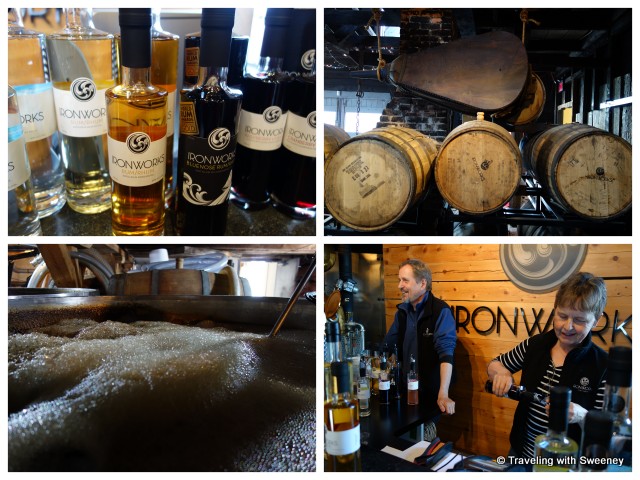
Pierre Guevremont and Lynne MacKay at Ironworks Distillery in the old blacksmith’s shop in Lunenburg
We sampled vodka (made from Annapolis Valley apples rather than grain or potatoes), rum, and brandies. The Apple Brandy (made from sweet McIntosh, organics like Cortland and Liberty, and Honeycrisp) struck my fancy the most. When the idea of a cocktail challenge with my companions came up, I knew immediately that it would be a key ingredient in my Nova Scotia Surprise recipe. Another favorite for taste and its gorgeous color is the Cranberry Liqueur, made with berries from a local cranberry farm.
Raw scallops – Nova Scotia is known for their scallops and that has always been my favorite seafood. I had several wonderful meals that included them while in Nova Scotia and I’ve been craving them ever since. However, I’d never tried raw scallops and the prospect didn’t seem particularly appetizing. So when I decided to take a bite of a raw, fresh scallop just carved from the shell at the Fisheries Museum of the Atlantic in Lunenburg, I didn’t have high expectations. It was a small bite, but a big move forward – and it tasted just like the sea.
Herring – My husband’s family loves pickled herring and consider it one of the finest Christmas holiday treats. I’ve always turned it down. But at the Foodland market in Lunenburg, I was encouraged to try it and was surprised by the pleasant flavor. It wasn’t nearly as fishy as I thought. I guess I’ll be joining in the family herring-fest next Christmas.
Blueberries – The official provincial berry, Nova Scotia grows more blueberries than any other Canadian province. They are used in many dishes, creatively prepared in sauces or just served fresh. I was also pleasantly surprised to learn of Van Dyk’s 100% pure blueberry juice — no sugar added. It’s a pleasure to drink by itself, but it’s also great for making cocktails. Ironworks Distillery makes a tasty Blueberry Liqueur using Van Dyk’s blueberries.
Haskap – The Haskap berry is a member of the honeysuckle family. It looks like a long oval blueberry, but has a unique flavor somewhat like a combination of blueberry, raspberry and elderberry. It’s highly nutritious, too. Haskaps grow very well in Nova Scotia and are quite popular in juices and jams.
Cheese and gelato – what more does one need? It was a surprise to me to find first-rate homemade gelato in rural Nova Scotia, but that’s what they serve up at Fox Hill Cheese House where they have their own herd of Holstein and Jersey cows. Don’t forget to sample the numerous cheese options when you visit, too.
So that’s a taste of Nova Scotia. Are you ready to visit for some wining and dining? I know that I’m ready to return.
Thanks to Nova Scotia Tourism Agency and Taste of Nova Scotia for making my totally delicious culinary road trip possible.

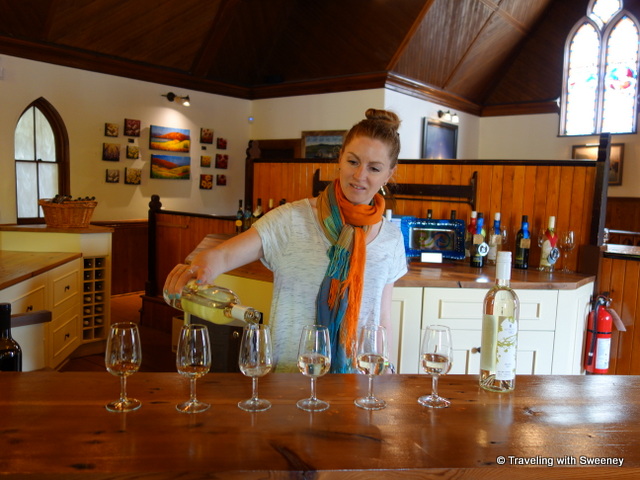



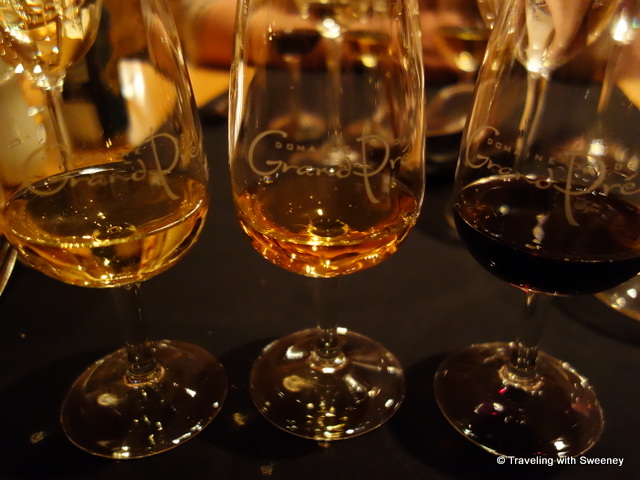
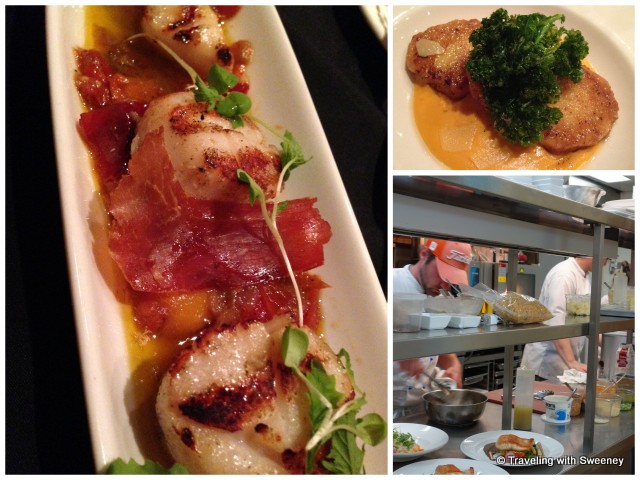
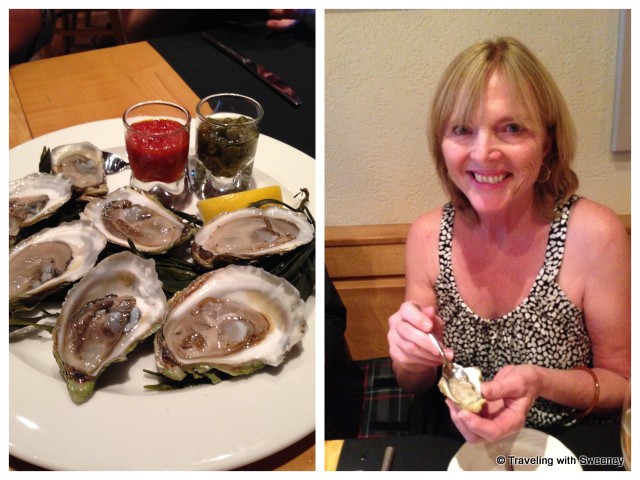

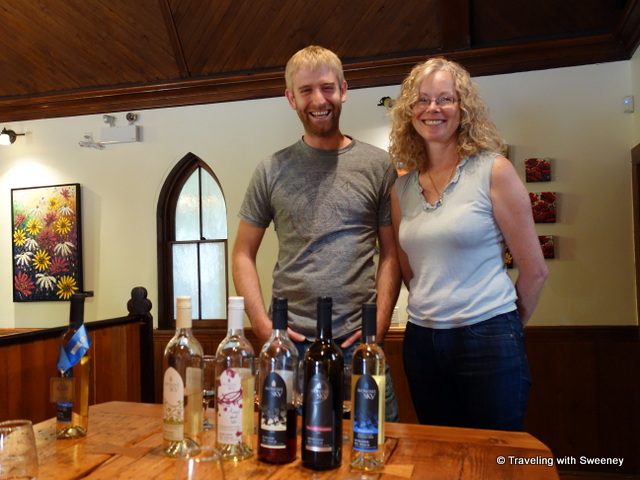
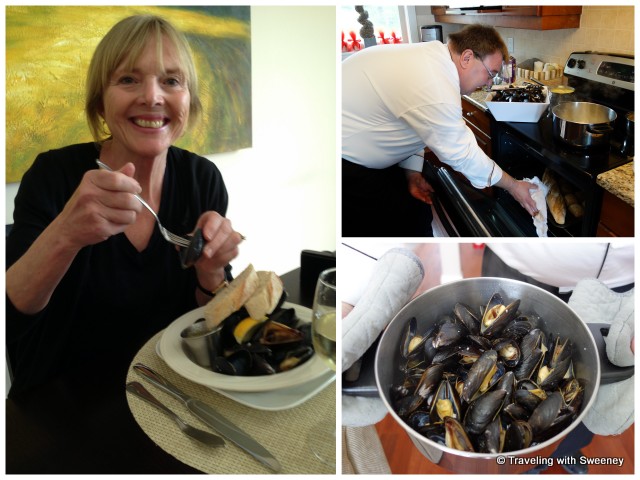
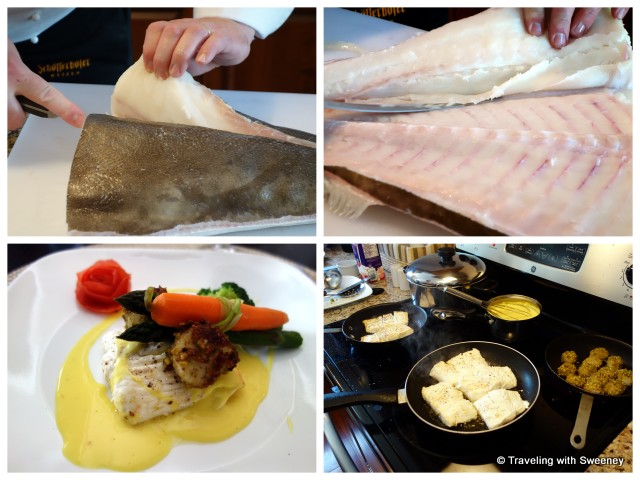
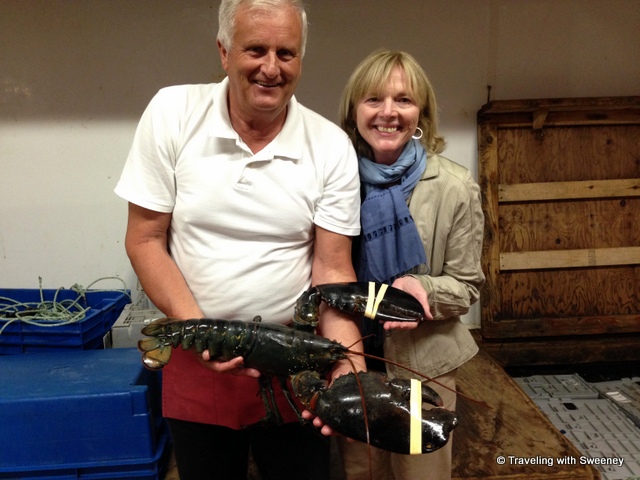
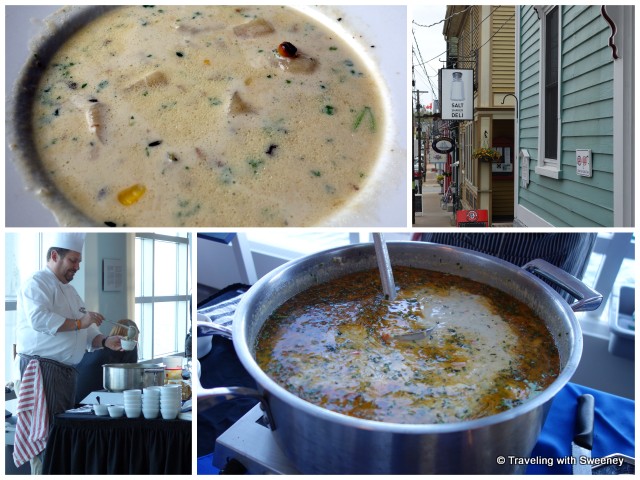
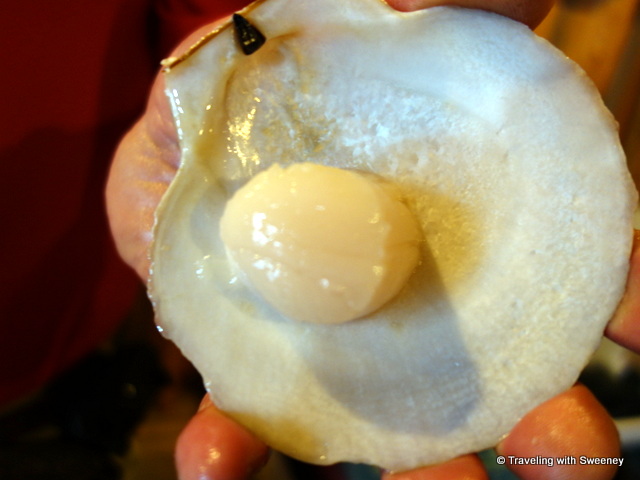





Leave a Reply